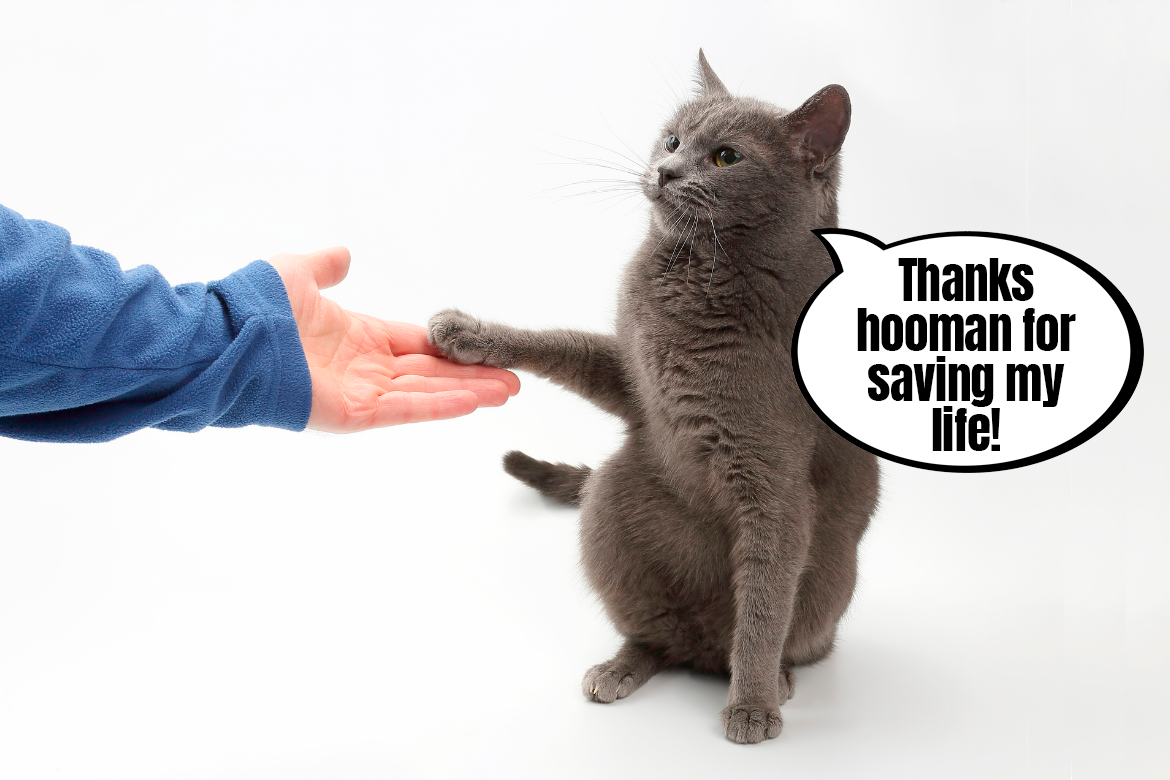Do cats have 9 lives? Though it’s true that our furry friends can survive a lot and get out of some strange situations without a scratch, we definitely can’t say they’re immortal. As responsible cat Carers we should have some resources and knowledge at hand to be able to help them in case of some unforeseen turn of events. And one of the basic, practical skills it’s good to have is first aid for cats. It’s a very broad subject, but today we’ll try to get you closer to some of the key elements and basic skills, dear fabCats, just so you are able to help your beloved cats if they ever require your assistance.
First aid for cats – the basics
Giving first aid to a cat or a human, we should always strive to not cause any harm. What it actually means is that we don’t need to have a broad medical knowledge or special training, but we should be able to help in a capacity that allows the injured to stay conscious and as comfortable as possible until the medical help arrives. If a cat gets wounded, let’s make sure they stay immobile and don’t get themselves into more trouble until we get them to the vet. It doesn’t seem like a lot, but it can save our pet from some serious complications.
How do we tell a cat is injured if we didn’t see them get hurt, but they behave differently? One of the symptoms that can be associated with both external and internal injuries is a particular pain position they tend to get in to protect themselves. A cat may be hunched over, with their head down, muscles on their face all tensed up, tail kept close to the body, eyes almost closed. If they’re in pain, they’re often apathetic, lacking appetite – their suffering may be more or less visible from the outside, but if the behavior itself worries us, it’s definitely worth it to check it with the vet.
When the pain is associated with more serious injuries, a cat may be in shock. It’s much more dangerous for cats than for people – it can lead to death, which is why we should never ignore it. Shock can give symptoms like weakness, trouble standing up and keeping balance, darkening and lightening of gums and lips, falling body temperature. Shock is most common with extensive blood loss and the symptoms are visible quite quickly, when the cat has lost about 10-15% of their blood, which is why being able to stop the bleeding quickly and get the cat to a hospital is of utmost importance.
First aid – step by step
Whether you’re giving first aid to your own pet or a cat found on the street, it’s good to follow the simple ABCD scheme that helps you keep the right order of actions. According to the scheme, we should focus on:
A – Airways – checking if they’re unobstructed and, if necessary, unblocking them to allow the cat to breathe.
B – Breathing. You can check if the animal is breathing by putting the back of your hand, a mirror, or even a grass blade to their nose, as it should move under the breath.
C – Circulation – you won’t feel it on the wrist of a cat, but you can put your hand to their chest or to the inner part of their back leg, around the knee, with your fingers on the inner side of the thigh and your thumb on the outside.
D – Disability, which basically means checking their physical state and if they react to any stimuli like touch, sound etc.
It’s good to try and make the preliminary evaluation while calling to the vet at the same time – the earlier you manage to get in contact with a vet who knows your cat or any other vet clinic nearby who can admit them right away, the better. And because of that, we also want to remind you that it’s always a good practice to have a phone number to your vet clinic and a 24/7 nearby clinic saved on the phone. You never know what your cats could get into at any given moment.
Baseline vital signs for cats
Information that could become quite useful when a cat’s life is at stake is, of course, their baseline vital signs we can refer to when examining the cat. It’s not something you must know, as you won’t always have a thermometer at hand or the time to check all the parameters, but it’s definitely information it’s good to be familiar with, especially when it comes to our own pets. Every cat can have slightly different vital signs that are normal to them, like a slightly faster heartbeat or breathing. Knowing what is the standard for your cat, you will be able to tell the vet any information that may be necessary to save your cat’s life.
Baseline vital signs for cats should be around:
- Pulse – 120-240 beats per minute (200-300 for kittens)
- Breaths at rest – 10-40 per minute,
- Body temperature – 38-38,5°C,
When you’re checking your cats vital signs, it’s also worth paying attention to the color of their skin and gums (pale can mean bleeding, dark red – dehydration or heat stroke, and yellow – liver issues), as well as their alertness and reactions, their hydration levels (if the skin on the neck is quickly going back to its place when you gently pull it, it’s ok, but if it’s not elastic and stays up, your can can be severely dehydrated).
Do cats require CPR?
Of course they do – if there’s cardiac arrest, the same rules apply to cats as to people, which means CPR is necessary to try and get the breathing back and heart pumping again.
CPR for cats should be performed with the cat lying on their right side. Put your hand on the chest, slightly above the heart, in the lower third of the chest, just so that your four fingers can rest on the ribs on the right-hand side, your palm on the belly and the thumb on the ribs on the left side. Do 100-120 chest compressions per minute, allowing for the chest to decompress after each one. At the same time, breathe into the cat’s nose, about 10 breaths per minute, holding their face in both hands to hold the mouth shut and breathing only into their nose.
Stress and panic are not your friends
To finish things off, let’s talk about one more important issue that’s easy to forget in critical situations. What we need to remember about is to stay calm, collected and ensure safety not only of our animal, but our own as well. It’s hard not to get scared when our pet gets seriously injured or acts lethargic. But in those dire situations it’s us, their Carers, who should stay conscious and ready to do what’s necessary. Being able to assess the situation, think straight and react quickly has saved many cat lives, allowing for help to get there as quickly as possible. Also, let’s remember that cats can feel the stress and mood of their Guardians and if we’re scared, they will be even more terrified.
Calmness in a critical situation can also guarantee that we ourselves will stay safe. When you’re giving first aid to a cat, it’s always worth having your own safety and health in mind and if you’re working on an aggressive cat (and even the most easy-going cats can get aggressive when they’re in pain) or a cat injured in an accident, always proceed with extreme caution.
As we said before, the topic of first aid is very complex. Today we took on the most basic information, but if you need more specialized info on how to bandage up wounds, deal with breaks or transport a cat with a visible injury, we recommend talking to your vet who will have more specific tips on that and will be able to give you some hands-on advice.
Did you, dear fabCats, ever have an emergency with your cats? Definitely let us know in the comments and remember – if we properly ensure the safety of our cats at home, it will be much easier to avoid accidents that would require immediate veterinary assistance.




